The AMD Radeon R9 295X2 Review
by Ryan Smith on April 8, 2014 8:00 AM EST- Posted in
- GPUs
- AMD
- Radeon
- Radeon 200
Compute
Our final set of performance benchmarks is compute performance, which for dual-GPU cards is always a mixed bag. Unlike gaming where the somewhat genericized AFR process is applicable to most games, when it comes to compute the ability for a program to make good use of multiple GPUs lies solely in the hands of the program’s authors and the algorithms they use.
At the same time while we’re covering compute performance for completeness, the high price and unconventional cooling apparatus for the 295X2 is likely to deter most serious compute users.
In any case, our first compute benchmark is LuxMark2.0, the official benchmark of SmallLuxGPU 2.0. SmallLuxGPU is an OpenCL accelerated ray tracer that is part of the larger LuxRender suite. Ray tracing has become a stronghold for GPUs in recent years as ray tracing maps well to GPU pipelines, allowing artists to render scenes much more quickly than with CPUs alone.
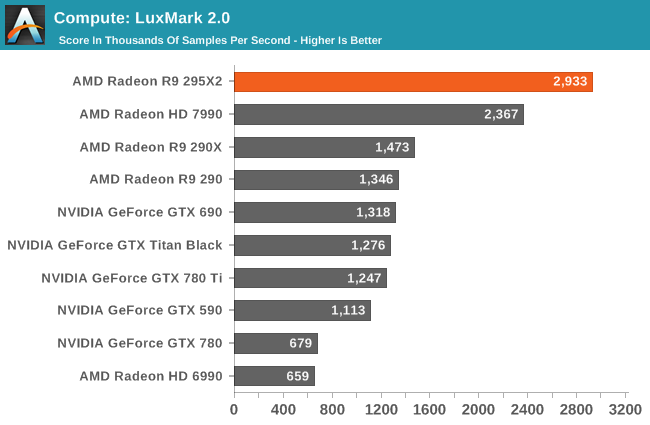
As one of the few compute tasks that’s generally multi-GPU friendly, ray tracing is going to be the best case scenario for compute performance for the 295X2. Under LuxMark AMD sees virtually perfect scaling, with the 295X2 nearly doubling the 290X’s performance under this benchmark. No other single card is currently capable of catching up to the 295X2 in this case.
Our second compute benchmark is Sony Vegas Pro 12, an OpenGL and OpenCL video editing and authoring package. Vegas can use GPUs in a few different ways, the primary uses being to accelerate the video effects and compositing process itself, and in the video encoding step. With video encoding being increasingly offloaded to dedicated DSPs these days we’re focusing on the editing and compositing process, rendering to a low CPU overhead format (XDCAM EX). This specific test comes from Sony, and measures how long it takes to render a video.
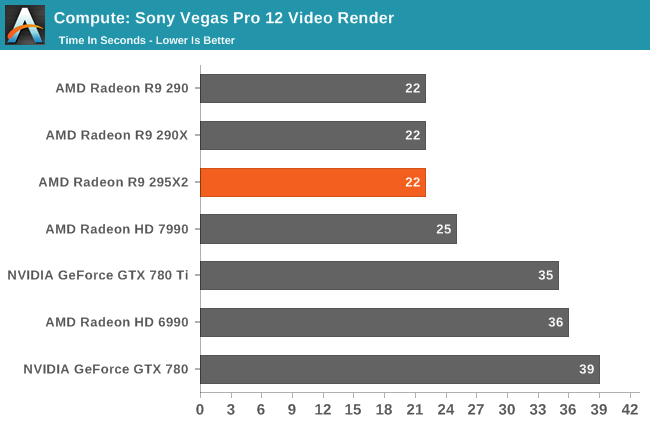
Sony Vegas Pro on the other hand sees no advantage from multiple GPUs. The 295X2 does just as well as the other Hawaii cards at 22 seconds, sharing the top of the chart, but the second GPU goes unused.
Our third benchmark set comes from CLBenchmark 1.1. CLBenchmark contains a number of subtests; we’re focusing on the most practical of them, the computer vision test and the fluid simulation test. The former being a useful proxy for computer imaging tasks where systems are required to parse images and identify features (e.g. humans), while fluid simulations are common in professional graphics work and games alike.
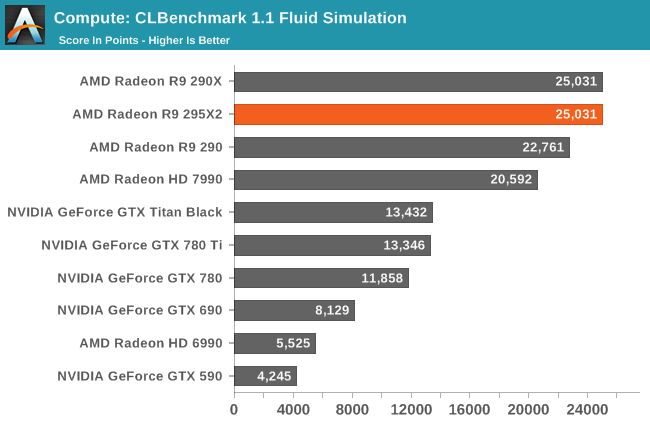

Like Vegas Pro, the CLBenchmark sub-tests we use here don't scale with additional GPUs. So the 295X2 can only match the performance of the 290X on these benchmarks.
Moving on, our fouth compute benchmark is FAHBench, the official Folding @ Home benchmark. Folding @ Home is the popular Stanford-backed research and distributed computing initiative that has work distributed to millions of volunteer computers over the internet, each of which is responsible for a tiny slice of a protein folding simulation. FAHBench can test both single precision and double precision floating point performance, with single precision being the most useful metric for most consumer cards due to their low double precision performance. Each precision has two modes, explicit and implicit, the difference being whether water atoms are included in the simulation, which adds quite a bit of work and overhead. This is another OpenCL test, as Folding @ Home has moved exclusively to OpenCL this year with FAHCore 17.
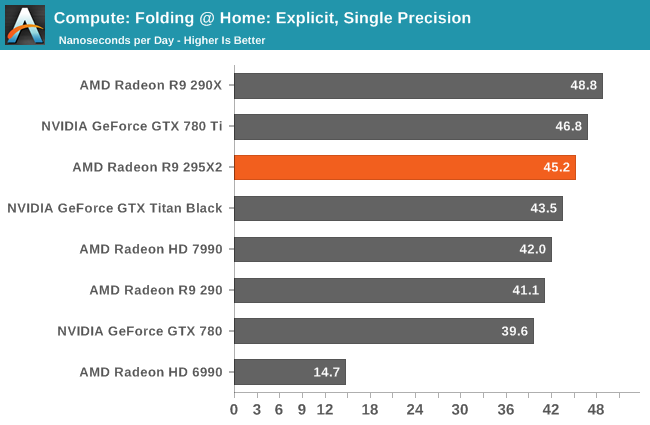
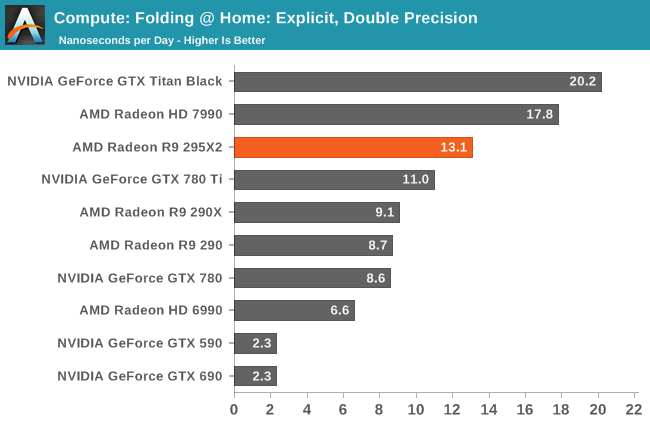
Unlike most of our compute benchmarks, Folding@Home does see some degree of multi-GPU scaling. However the outcome is really a mixed bag; single-precision performance ends up being a wash (if not a slight regression) while double-precision is seeing sub-50% scaling.
Wrapping things up, our final compute benchmark is an in-house project developed by our very own Dr. Ian Cutress. SystemCompute is our first C++ AMP benchmark, utilizing Microsoft’s simple C++ extensions to allow the easy use of GPU computing in C++ programs. SystemCompute in turn is a collection of benchmarks for several different fundamental compute algorithms, as described in this previous article, with the final score represented in points. DirectCompute is the compute backend for C++ AMP on Windows, so this forms our other DirectCompute test.
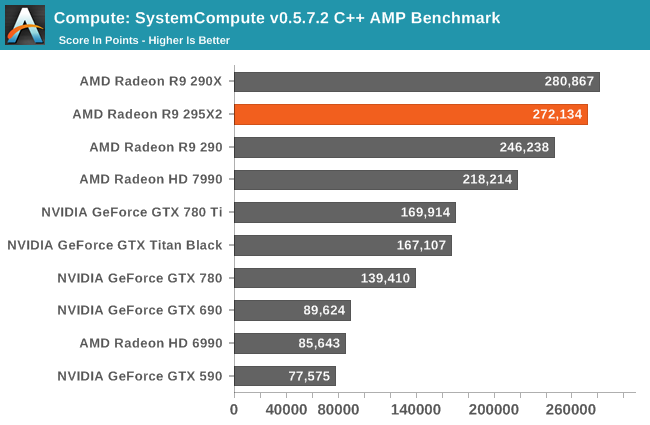
Our final compute benchmark has the 295X2 and 290X virtually tied once again, as this is another benchmark that doesn’t scale up with multiple GPUs.










131 Comments
View All Comments
Kevin G - Tuesday, April 8, 2014 - link
Typo:"The PCB itself is 14 layers, making it an especially intricate PCB, but one necessary to carry 500W while also routing 1028 GDDR5 lines and 48 PCIe 3 lanes."
I presume 1028 is actually representative of the combined 1024 bit wide memory bus.
Ryan Smith - Tuesday, April 8, 2014 - link
Noted and fixed. Thank you.CiccioB - Tuesday, April 8, 2014 - link
Isn't 500W from 2x8 + PCI-E out of standards and connctor specifics and somewhat dangerous?ShieTar - Tuesday, April 8, 2014 - link
Its out of spec, as also discussed in the article, but very unlikely to be dangerous. 215W at 12V over 3 wires will draw about 6A per wire, still significantly below what the ATX standard considers safe:"Under normal or overload conditions, no output shall continuously provide more than 240 VA".
The interesting question will be if the PSUs are up to the task of filtering the rapid switching between almost 0W and up to 425W on the rail which feeds the two connectors. But most modern, high power PSUs feed even more connectors on a single rail, so they should have little problem. And whoever mates a 1500$ GPU with a cheap PSU has nobody to blame but himself.
LoccOtHaN - Tuesday, April 8, 2014 - link
Really fine Card for 4k gaming. Nice Job AMD/ATI and 1498$ is not expensive for Entusiast Level of Hardware. NICECiccioB - Tuesday, April 8, 2014 - link
Broken frame pacing does not really put this card as the best choice for playing, IMHO.LasseGrr - Tuesday, April 8, 2014 - link
@CiccioB Maybe try reading the article again...CiccioB - Tuesday, April 8, 2014 - link
You may look at those frame per seconds graphs more closely. When provided, those graphs do not show good frame pacing timings, and where not provided, look to other site's reviews.But then, I'm sure who ever spend $1500 for a gaming card has all the reason to convince himself that the card is good nonetheless.
extide - Tuesday, April 8, 2014 - link
What are you talking about?? First of all, an FPS graph shows NOTHING about frame timing variance.Second of all, they DO specifically show the frame timing, in different graphs, and it is fine, very similar to nVidia's results!
Are you not able to read or something?!
CiccioB - Wednesday, April 9, 2014 - link
Sorry, but what kind of graph are you looking at?First, not all reviewed games here have a frame pacing graph.
Second, look at BF4, Crysis3, Thief graphs for example. Where do you see this card being better than a SLI of 780Ti?
The FPS graphs are a mess for this 295x2. Ideally those graphs should be a thin line, not an area where the frame per seconds continously oscillate.
But, well, as said, once you spend (or want to spend) $1500 you have to convince yourself there are no problems. The same was true for 7990 buyers that glorified that card. See now what a crappy card it is. And that was also true for all those that negated that AMD Crossfire configurations had problem with respect to nvidia ones before AMD tried to correct the problem with new drivers (that somewhat now work for DX11 games but not with DX9 and 10 ones, and that's maybe the reason that for older games there's not the frame pacing graphs...).